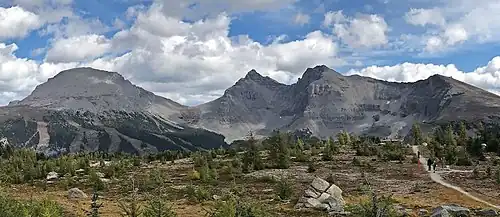Eagle Mountain (Alberta)
Eagle Mountain is a 2,836-metre (9,304-foot) mountain summit located immediately northeast of the Banff Sunshine ski resort in Banff National Park of Alberta, Canada. The mountain's toponym was officially adopted in 1958 by the Geographical Names Board of Canada.[3] The nearest higher neighbor is Mount Howard Douglas, 1.51 km (0.94 mi) to the south-southeast.[1]
| Eagle Mountain | |
|---|---|
 Eagle Mountain in February 2011 | |
| Highest point | |
| Elevation | 2,836 m (9,304 ft)[1] |
| Prominence | 321 m (1,053 ft)[2] |
| Listing | Mountains of Alberta |
| Coordinates | 51°05′51″N 115°44′41″W[3] |
| Geography | |
 Eagle Mountain Location of Eagle Mountain in Alberta  Eagle Mountain Eagle Mountain (Canada) | |
| Location | Banff National Park Alberta, Canada |
| Parent range | Canadian Rockies |
| Topo map | NTS 82O4 Banff |
| Climbing | |
| Easiest route | Hiking[4] |
An interesting feature of Eagle Mountain is a natural window officially named Goat's Eye[5] located on the northeast ridge which leads many to call it Goat's Eye Mountain. It was first noted by George Simpson who wrote of it: "a very peculiar feature in an opening of about eighty feet by fifty, which, as we advanced nearer, assumed the appearance of the gateway of a giant's fortress."[6]
Geology
Like other mountains in Banff Park, Eagle Mountain is composed of sedimentary rock laid down from the Precambrian to Jurassic periods.[7] Formed in shallow seas, this sedimentary rock was pushed east and over the top of younger rock during the Laramide orogeny.[8]
Climate
Based on the Köppen climate classification, Eagle Mountain is located in a subarctic climate zone with cold, snowy winters, and mild summers.[9] Winter temperatures can drop below -20 °C with wind chill factors below -30 °C. Precipitation runoff from Eagle Mountain drains into tributaries of the Bow River.
See also
References
- "Eagle Mountain, Alberta". Peakbagger.com. Retrieved 2021-01-27.
- "Eagle Mountain". Bivouac.com. Retrieved 2021-01-27.
- "Eagle Mountain". Geographical Names Data Base. Natural Resources Canada. Retrieved 2019-03-27.
- "Eagle Mountain (Goat's Eye)". explor8ion. Retrieved 2019-03-27.
- "Goat's Eye". Geographical Names Data Base. Natural Resources Canada. Retrieved 2019-03-27.
- "Eagle Mountain". cdnrockiesdatabases.ca. Retrieved 2019-08-25.
- Belyea, Helen R. (1960). The Story of the Mountains in Banff National Park (PDF). parkscanadahistory.com (Report). Ottawa: Geological Survey of Canada. Archived (PDF) from the original on 2015-10-02. Retrieved 2019-09-13.
- Gadd, Ben (2008), Geology of the Rocky Mountains and Columbias
- Peel, M. C.; Finlayson, B. L.; McMahon, T. A. (2007). "Updated world map of the Köppen−Geiger climate classification". Hydrol. Earth Syst. Sci. 11: 1633–1644. ISSN 1027-5606.
External links
- Parks Canada web site: Banff National Park

